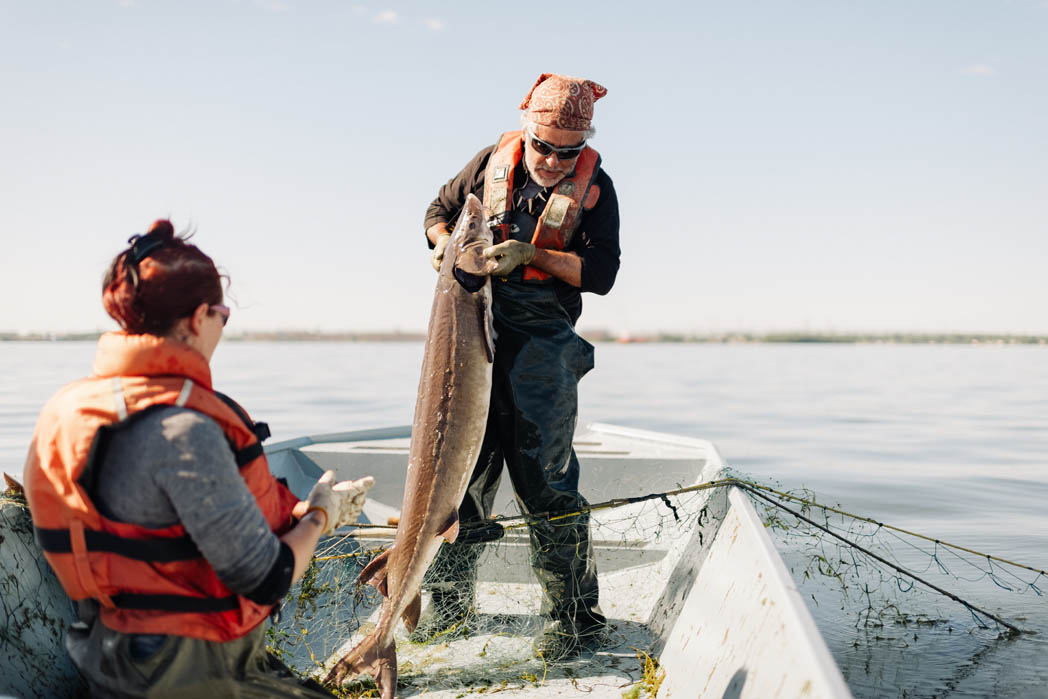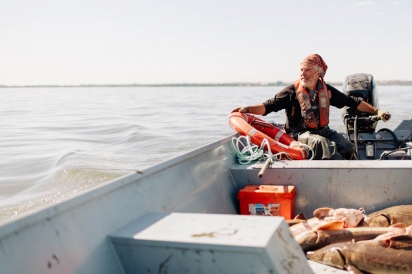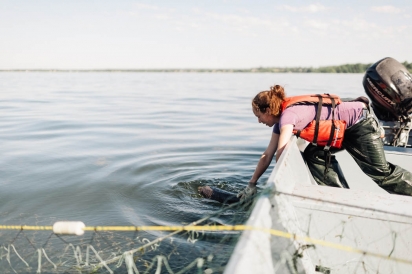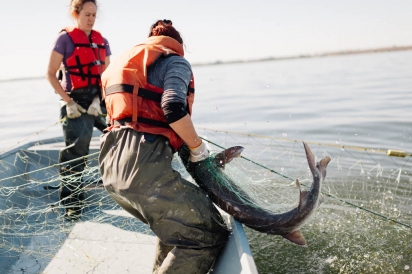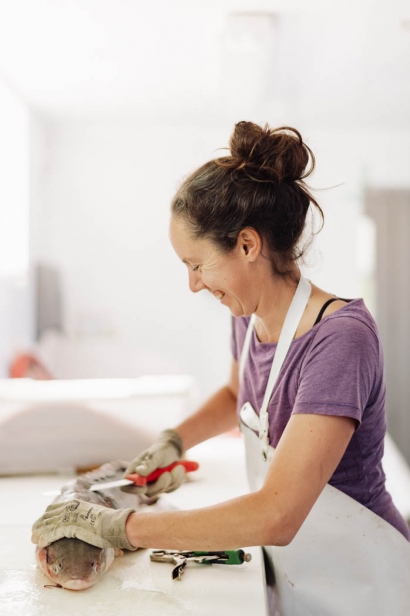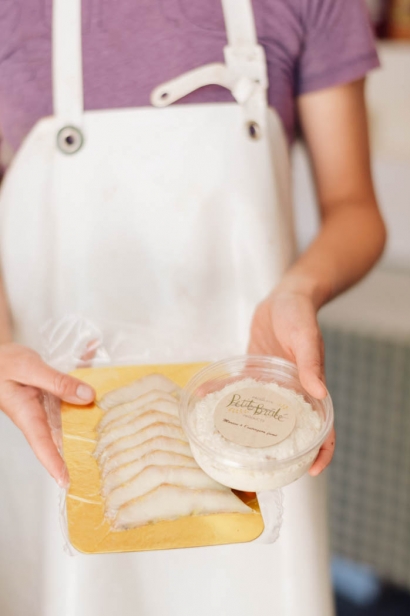Sustainable Sturgeon
It’s a dazzling June morning on Lac St. Louis, at the junction of the Ottawa and St. Lawrence rivers, and from my seat in the custom fishing boat, I can see the West Island of Montréal through the dissolving haze. At 8 a.m., the air is still cool and Michel La Haye, his wife Fabienne Côté, and their helper Vanessa Séguin, are preparing to haul in their first lake sturgeon of the day. La Haye was on the water hours earlier scouting for places to anchor his gillnets, single walls of vertical netting lined with floats at the top and weights at the bottom. He looks for calm stretches of water and signs of recent sturgeon activity. The fish may signal their presence by leaping into the air, but a more common indicator is the yellowish tinge the water takes on when sturgeon forage for food in the sand, gravel and mud below. “I’ve fished here since 1993,” says La Haye, a commercial fisherman and fish biologist who is committed to sustainable fishing practices. “I know the lake by heart and love sturgeon fishing at this time of year.”
As Côté and Séguin begin pulling in the first net, a sturgeon surfaces, its gills caught in the eight-inch mesh shown to be the best gauge for conserving fish stocks and ensuring an adequate harvest. The writhing sturgeon poses no problem for these fit young women who have wrestled with much bigger catch. They quickly disentangle it, stun it so it won’t thrash, and slide it into the back of the boat where we can all get a closer look.
Sturgeon is not your average fish. In fact, it's a sort of aquatic dinosaur whose origins can be traced back more than 200 million years. Like other species of sturgeon in North America, the lake, or yellow sturgeon as it’s sometimes known, has no scales, a skeleton that’s more cartilage than bone, and a streamlined, torpedolike body, ridged with bony plates called scutes that run along the sides and back. When it feeds, it stirs up sediment with its long snout, on the hunt for insect larvae, crayfish, mollusks and worms. Four sensory organs, known as barbels, dangle from its mouth, helping it locate prey that it sucks up with rubbery, prehensile lips and swallows whole because it doesn’t have teeth. The species takes a long time to become sexually mature and spawns infrequently (every four years or longer for females, and every one to three years for males) — characteristics that make it especially vulnerable to over-fishing and habitat loss.
Côté, Séguin and La Haye land seven more sturgeon today minus several that are released because they are too big or too small. They expect a similar number from their second gillnet. That’s lower than their usual daily catch in the June season (a second sturgeon season runs from mid-September to the end of October), but the cold spring has delayed the movement of the fish upstream. Once each net is emptied, the sturgeon are bled to soften their muddy flavour, put on ice, and brought to Le Petit Brûlé, the farm and small-scale processing plant La Haye and Côté own near St-Eugène, Ont., minutes from the Québec border. There, Côté smokes the sturgeon, which she sells to retailers and restaurants, mostly in the Ottawa region. In the fall, she prepares small quantities of caviar. The couple believes they are the only ones producing sustainable, wild smoked sturgeon and caviar in Eastern Ontario — and maybe the entire province.
Although sturgeon are listed on the federal Species at Risk Act, classified as endangered by the Committee on the Status of Endangered Wildlife in Canada (COSEWIC) and considered unsustainable by Ocean Wise, lake sturgeon stocks are actually thriving along the lower St. Lawrence where La Haye and Côté fish. Thanks to strictly enforced quotas and other rigorous management policies brought in by the Québec government in 2000, studies demonstrate a steady rise in wild sturgeon numbers downstream from the Beauharnois dam west of Montréal. The revised quotas, which La Haye played a part in developing, have eliminated poaching and helped recolonize abandoned spawning grounds. Despite repeated requests from biologists at the Wildlife Ministry of Québec, COSEWIC and Ocean Wise have been reluctant so far to change their assessments to accommodate a small subset of sturgeon in the lower St. Lawrence. In the meantime, La Haye and Côté are confident that they are sourcing from a plentiful fishery, using sustainable practices that include zero bycatch. “We do things ecologically or not at all,” he says.
The couple’s stance isn’t surprising: both are wildlife biologists who met working on a conservation study on the Ottawa River in 2004. They married and had two daughters, and for several years juggled family duties with wildlife consulting projects and fishing. Then their lives took a different turn. The sturgeon fisherman with whom La Haye had teamed with since the early 1990s decided to get out of the business and offered him his fishing licence. La Haye and Côté couldn’t ignore the business opportunities having their own supply of fish would provide. In the years that followed, the couple bought a house near St. Eugène, built a small processing facility and retail store on the property and launched Le Petit Brûlé in 2014 as a micro-processor specializing in smoked yellow sturgeon. In addition to their own products, they retail foods from other local producers such as fresh vegetables, soups, sauces and prepared meals.
Although they do sell small quantities of unprocessed sturgeon, most of their yearly average catch of 3,300 pounds is transformed into higher-end products. “Transforming respects better the local economy and the value of the fish,” Côté explains. As soon as fresh sturgeon arrive at the plant, she cleans and filets them, storing them in a cold chamber for two or three days before putting them in the freezer. Once she receives a product order, she thaws, brines and dries the fish, smokes it for four to six hours, and then cools and packages it. She uses what she describes as an old fisherman’s recipe for the smoking that she has adapted to adhere to Ontario regulations, and only processes fish that La Haye has caught so she knows exactly what she’s selling. Besides sturgeon and caviar, she has tried her hand at processing carp and catfish and developed a sturgeon mousse that’s tasty spread on crackers or toast.
The Red Apron in Ottawa, which carries Le Petit Brûlé’s 100- gram packages of sliced smoked sturgeon, is an enthusiastic customer. “We love the smoked sturgeon,” says co-owner Jennifer Heagle. “It’s such a luxurious treat for us to be able to get locally, as well as a versatile ingredient to have on hand in your freezer. We recommend it with bagels and cream cheese, as an elegant canapé, or tossed in with a creamy pasta. Côté has done several instore tastings and customer feedback has always been excellent.”
Not content to rest on their laurels, La Haye and Côté are eager to expand their offerings. Côté has plans for a fish broth and is working on carp teramasalata, a traditional Greek and Turkish appetizer made from carp roe, olive oil, lemon juice, grated onions and bread.
To furnish her with new species to process, La Haye has recently been granted an Ontario licence to fish carp, bullhead catfish, black crappie and other varieties starting in September.
But it may be tough to beat the pure pleasure of sturgeon fishing in June, he says. “The days are long, the water is super-calm and you’re depending only on your own knowledge and skill. It’s just you and nature.”
Le Petit Brûlé
105 Concession Rd., St. Eugène, Ont.
petitbrule.ca, 613.674.1816
Six tips on cooking lake sturgeon
.......................................................................................................................
Matthew Shepheard, chef of Mariposa Farm's restaurant, recently served wild, unprocessed sturgeon from Le Petit Brûlé at a tasting dinner at Oz Kafe. Here are his tips on preparing and cooking the fish:
1. Trim away bones, cartilage and fat with a sharp knife.
2. Sturgeon is strong-tasting, so rinse it thoroughly, especially if it was previously frozen. If it has been cryovac sealed, rinse it and let it "breathe" for a day or two before cooking.
3. Sturgeon stands up to stronger flavours, sauces and accompaniments such as lemon, caper, parsley and butter sauce.
4. Before cooking, season the fish with salt and maybe a bit of sugar to even out the flavour and firm up the flesh for roasting.
5. Rinse again and pat dry.
6. Roast in a heavy-bottomed pan with a bit of butter at 375F to 400F for approximately 8 minutes, depending on the size of the piece.


